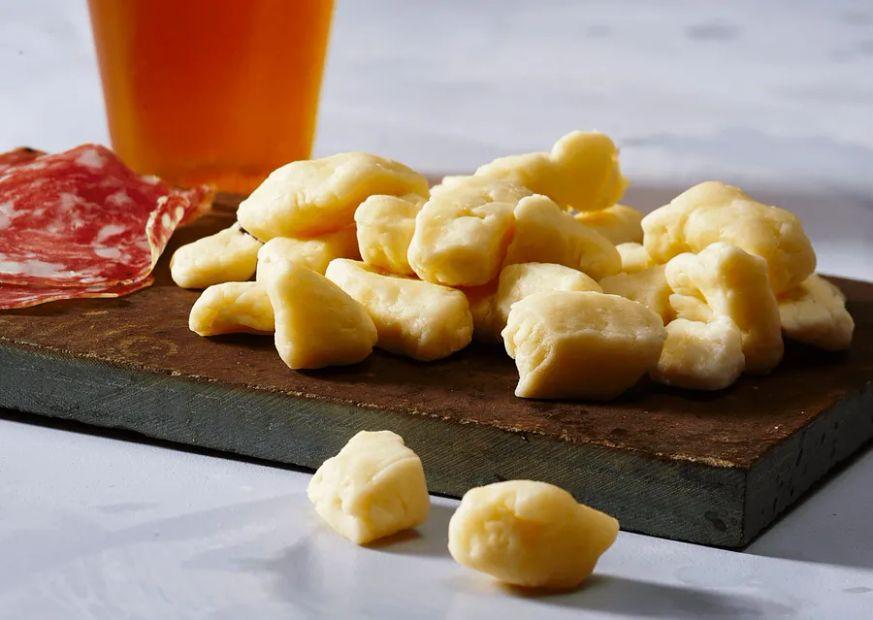6 Surprising Facts You Didn't Know About Cheese Curds

Cheese curds are a staple in the Midwest, but if you're outside that area, how can you be sure you're tasting the real thing? We asked an expert for insights.
Wisconsin proudly calls itself America's Dairyland. It's on their license plates, and when you arrive at the airport, you're welcomed with fresh cheese. Fans of the Green Bay Packers even refer to themselves as cheeseheads. Simply put, Wisconsin is a cheese lover's paradise.
I had the privilege of meeting with several Wisconsin cheesemakers to learn about their sourcing methods, their world-renowned cheese production, and what makes cheese curds so unique — especially to those outside the Midwest. As someone not from the region, I found curds to be a bit of a mystery, often first encountered in their deep-fried form. I'd heard of them and tasted a few, but I didn't fully grasp what made them so distinctive or so quintessentially Wisconsin.
To celebrate National Cheese Curd Day, I sat down with Wisconsin Master Cheesemaker Bob Wills, whom I met at his Cedar Grove Cheese facility in Plain, Wisconsin. (He also owns Clock Shadow Creamery in Milwaukee.) We talked curds — what they are, how they're made, and why they squeak. Grab a few fresh curds and read on to discover what makes these bites of cheese so special.

1. Freshness is the key when it comes to cheese curds.
Unlike most cheeses, which are aged to achieve their perfect flavor and texture, cheese curds are meant to be fresh. If you're outside Wisconsin or the Midwest, the curds you find at your local store probably aren’t the real thing.
"There are cheese curds, and then there are Wisconsin cheese curds," says Wills. "No matter where you are, whether it’s Birmingham or a service station in Wisconsin, what sets them apart is their freshness. Wisconsin has specific state regulations allowing cheese curds to be sold within a day of being made, without refrigeration."
He adds, "If they aren’t sold by then, they must be thrown away," explains Wills. "Those fresh, warm cheese curds are the top-tier product — unless you're lucky enough to work at the factory and grab them straight from the vat."
Outside Wisconsin, there aren’t such strict guidelines. This means that the curds you pick up at your local store might not be fresh at all.
"Naturally, this presents a logistical problem and could lead to waste. To address this, sellers use various methods to extend shelf life, including refrigeration, gas flushing, or vacuum packing. Generally, the longer the shelf life, the lower the quality of the curds."
2. Cheese curds are simply young cheddar.
A cheese curd isn’t a distinct type of cheese — it’s just fresh, unaged cheddar. These curds are separated from the whey during the cheesemaking process and, instead of being molded into a full cheese wheel, are immediately bagged and sold. It’s a quick source of income for cheesemakers who typically have to wait months or even years for their cheeses to be ready for sale.
"All cheese begins with curds that bind together to form the cheese. However, most cheese varieties start with tiny curds, roughly the size of a grain of rice or the eraser on a pencil," Wills explains. "The larger curds people know come from the traditional cheddaring process. In this method, small curds fuse into slabs, which are turned and stacked to expel excess whey and trapped air. The result is smooth, uniform mats, which are then milled into larger curds. This technique was developed for aging cheddar over time. Ironically, these curds became a popular snack eaten within hours."

3. A good curd should squeak.
If your curd doesn’t squeak, it’s not fresh.
"The squeak of fresh cheese curds comes from the long strands of protein rubbing against your teeth enamel," explains Wills. "As cheese matures, enzymes and coagulants break down the proteins and milk components into smaller fragments. This process causes the curds to lose their squeak, typically within three or four days."
But if you're craving that squeak, there's a trick to bring it back. Pop the curds in the microwave for a few seconds over the next couple of days, and they might start squeaking again. While not quite as fresh as before, they’re still fun to eat.
4. Old curds aren’t bad; they’re just cheese.
Even if your curds are no longer fresh, they’re not ruined. "Curds that have been vacuum-sealed or gas-flushed for over a week are simply regular cheese," says Wills. "Older curds can still be great in salads, poutine, eggs, or when breaded and deep-fried." He adds, "If you’re worried about having too many curds, freeze them. Once thawed, they'll break down faster, but eaten within hours, they’ll taste almost like fresh. For deep-frying, if they’re breaded while fresh — tempura, cornmeal, seasoned flour, or pancake batter work well — and frozen quickly, they’ll fry up chewy, stringy, and delicious."
5. Flavored curds are becoming more popular.
Gone are the days of just white and yellow cheese curds. Cheesemakers are getting more inventive with the flavors they offer.
"Flavored cheese curds have gained immense popularity," Wills shares. "Some examples include Cajun, olive, horseradish, garlic, scorpion pepper, and ranch. We’ve even dipped cheese curds on skewers in a chocolate fountain." Wills even offers pizza-flavored cheese curds.
6. Some so-called "curds" are really just cheese chunks.
Some producers break up aged cheddar into chunk-like pieces and label them as fresh curds — but they’re not. Real cheese curds have a very short shelf-life, making them harder to sell. It’s much easier to sell cheese that lasts longer, which explains the misleading labeling.

1

2

3

4

5
Evaluation :
5/5